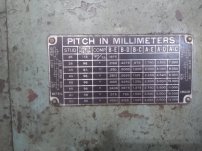I have been through the the posts on the metric transposing gears for the 13" double tumbler lathe with 6TPI leadscrew and I am not really finding the answer. The factory set used a 120:127 set but this is huge and almost impossible to obtain. There is someone selling a set of 3D printed gears on eBay but it does not appear to be 120:127 and he states that it is not exact so I assume that it is some other set. The 37:47 or 63:80 work on the other lathes with 8TPI leadscrew. Any idea what the gears that he is selling may be? I have been trying to figure this out until I am seeing double or triple and have not come close to an answer.


SOUTH BEND 13 Metal Lathe, METRIC Thread Cutting Gear Set! | eBay
SOUTH BEND 13 LATHE Double Tumbler 6TPI. You will NOT be. SOUTH BEND LATHE 13" (Using Double Tumbler QCGB). Maybe better than your lathe and slightly worn lead screw can produce! See below Chart/Table.
www.ebay.com




